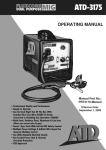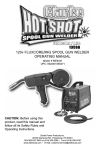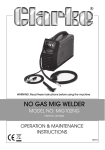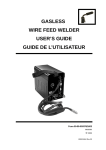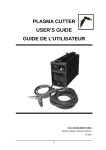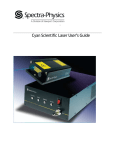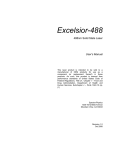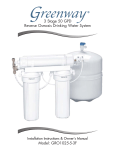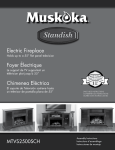Download Clarke WE6494A Operating instructions
Transcript
220V PLASMA CUTTER OPERATING MANUAL Model WE6494A UPC: 052249010173 CAUTION: Before using this product, read this manual and follow all its Safety Rules and Operating Instructions. Clarke Power Products Inc. 28740 Glenwood Rd., Perrysburg, OH 43551 Tel # 800-227-9603 or (419) 930-2299 - Fax # 877-354-0740 www.clarkeusa.com - E-mail: [email protected] TABLE OF CONTENTS Warranty ..............................................2 Safety Summary ..................................3 Safety Information ..............................3 Shock Hazards ..................................4 Flash Hazards ....................................4 Fire Hazards ......................................5 Plasma Arc Hazards ..........................6 Fume Hazards....................................6 Additional Safety Information ............7 Plasma Cutter Specifications ............8 Description ........................................8 Operating Characteristics ..................8 Duty Cycle........................................8 Internal Thermal Protection..............8 Pneumatic Protection ......................8 Electric Shock Protection ................8 Know Your Plasma Cutter ..................9 Plasma Cutter Installation ..................10 Site Selection ....................................10 Power Source Connection ................10 Power Requirements........................10 Connect to Power Source ................10 Extension Cords ..............................10 Assembling the Plasma Cutter ..........10 Unpacking the Plasma Cutter ..........11 Packing List......................................11 Operation ............................................11 Connecting the Air Supply..................11 Connecting the Ground Clamp to the Workpiece ..........................................12 Powering Up the Unit ........................12 Principles of Plasma Cutting ..............12 Learning to Plasma Cut......................13 Holding the Torch ............................13 Position the Torch to the Workpiece 13 Cutting ................................................13 Piercing ..............................................14 Recommended Cutting Speeds ........14 Maintenance ........................................15 Draining Condensation ......................15 Replacing the Nozzle ........................15 Replacing the Electrode ....................16 Replacing the Swirl Ring ....................16 Replacing the Nozzle Cap..................16 Troubleshooting..................................16 Wiring Diagram....................................18 Parts List ..............................................19 WARRANTY This product has a one year warranty covering any manufacturing defects. Even though we have strict quality control during our manufacturing process, sometimes a product gets shipped that does not meet our specifications. If you have a product that does not work correctly within 30 days of your purchase, take the product and the original receipt to the store for credit or replacement. If you have a product that does not work correctly when it is more than 30 days after your purchase, then you must return the product to the following address—postage or UPS paid. After 30 days, please do not return the product to the store. This will only delay the repair process. Consumable items such as motor brushes, blades, bulbs etc. are not covered under warranty. Before returning any product, you must contact Clarke Power Products at 1-800-227-9603 to acquire a Return Authorization Number. When sending your product you must include: 1. A copy of the dated store receipt showing the original purchase, 2. Name of store and town where product was purchased, 3. Your full name, street address and telephone number. Please ship to: Clarke Power Products Inc., 28740 Glenwood Road, Perrysburg, OH 43551 ATTN: Warranty Return We will examine the product. If the problem is due to a manufacturing defect, we will repair or replace the product at no charge and return it to you postage or UPS paid. If the problem is due to misuse, abuse, the product has been modified or out of warranty, we will contact you with a repair estimate and ask for a credit card number for payment. After the product has been repaired, it will be returned postage or UPS paid. 2 SAFETY SUMMARY TABLE OF CONTENTS Every craftsman respects the tools with which they work. They know that the tools represent years of constantly improved designs and developments. The true craftsman also knows that tools are dangerous if misused or abused. Note: • The following safety alert symbols identify important safety messages in this manual. • When you see one of the symbols shown here, be alert to the possibility of personal injury and carefully read the message that follows. This symbol indicates that the possibility of electric shock hazard exists during the operation of the step(s) that follow. Reading this operator’s manual before using the plasma cutter will enable you to do a better, safer job. Learn the plasma cutter’s applications and limitations as well as the specific potential hazards peculiar to plasma cutting. This symbol indicates that the possibility of fire hazard exists during the operation of the step(s) that follow. IMPORTANT SAFETY INFORMATION This symbol indicates that the helmet must be worn during the step(s) that follow to protect against eye damage and burns due to flash hazard. The following safety information is provided as guidelines to help you operate your new plasma cutter under the safest possible conditions. Any equipment that uses electrical power can be potentially dangerous to use when safety or safe handling instructions are not known or not followed. The following safety information is provided to give the user the information necessary for safe use and operation. This symbol indicates that the possibility of toxic gas hazard exists during operation of the step(s) that follow. This symbol indicates that the possibility of being burned by hot slag exists during operation of the step(s) that follow. A procedure step preceded by a WARNING is an indication that the next step contains a procedure that might be injurious to a person if proper safety precautions are not heeded. This symbol indicates that the eye protection should be worn to protect against flying debris in the following step(s). A procedure step preceded by a CAUTION is an indication that the next step contains a procedure that might damage the equipment being used. A NOTE may be used before or after a procedure step to highlight or explain something in that step. READ ALL SAFETY INSTRUCTIONS CAREFULLY before attempting to install, operate, or service this plasma cutter. Failure to comply with these instructions could result in personal injury and/or property damage. RETAIN THESE INSTRUCTIONS FOR FUTURE REFERENCE. • This symbol indicates that the possibility of injury or death exists due to improper handling and maintenance of compressed gas cylinders or regulators. Published standards on safety are available. They are listed in ADDITIONAL SAFETY INFORMATION at the end of this SAFETY SUMMARY. The National Electrical Code, Occupation Safety and Health Act regulations, local industrial codes and local inspection requirements also provide a basis for equipment installation, use, and service. 3 SHOCK HAZARDS WARNING ELECTRIC SHOCK CAN KILL! To reduce the risk of death or serious injury from shock, read, understand, and follow the following safety instructions. In addition, make certain that anyone else who uses this equipment, or who is a bystander in the operating area understands and follows these safety instructions as well. • IMPORTANT! TO REDUCE THE RISK OF DEATH, INJURY, OR PROPERTY DAMAGE, DO NOT ATTEMPT OPERATION of this equipment until you have read and understand the following safety summary. • Do not, in any manner, come into physical contact with any part of the cutting current circuit. The cutting current circuit includes: a. the work piece or any conductive material in contact with it, b. the ground clamp, c. the torch, d. any metal parts on the torch. • Do not operate in a damp area or come in contact with a moist or wet surface. • Do not attempt to operate if any part of clothing or body is wet. • Do not allow the equipment to come in contact with water or moisture. • Do not drag cables, cutting torch, or power cord through or allow them to come into contact with water or moisture. • Do not touch unit or attempt to turn unit on or off if any part of the body or clothing is moist or if you are in physical contact with water or moisture. • Do not attempt to plug the unit into the power source if any part of body or clothing is moist, or if you are in physical contact with water or moisture. • Do not connect ground clamp to or cut on electrical conduit. • Do not alter power cord or power cord plug in any way. • Do not attempt to plug the unit into the power source if the ground prong on power cord plug is bent over, broken off, or missing. 4 • • • • • • Do not allow the unit to be connected to the power source or attempt to operate if the unit, cables, work area, or power cord are exposed to any form of atmospheric precipitation, or salt water spray. Do not carry coiled cables around shoulders, or any other part of the body, when they are plugged into the unit. Do not modify any wiring, ground connections, switches, or fuses in this equipment. Wear welding gloves to help insulate hands from cutting circuit. Keep all liquid containers far enough away from the unit and work area so that if spilled, the liquid can not possibly come in contact with any part of the unit or electrical circuit. Replace any cracked or damaged parts that are insulated or act as insulators such as cables, power cord, or electrode holder IMMEDIATELY. . FLASH HAZARDS WARNING ARC RAYS CAN INJURE EYES AND BURN SKIN! To reduce the risk of injury from arc rays, read, understand, and follow the following safety instructions. In addition, make certain that anyone else that uses this equipment, or is a bystander in the work area understands and follows these safety instructions as well. Headshields and filter should conform to ANSI Z87.1 standards. • • • Do not look at an electric arc without proper protection. A cutting arc is extremely bright and intense and, with inadequate or no eye protection, the retina can be burned, leaving a permanent dark spot in the field of vision. A shield or helmet with a number 8 shade filter lens (minimum) must be used. Do not strike an arc until all bystanders and the operator have protective shields and/or helmets in place. Do not wear a cracked or broken helmet and replace any cracked or broken filter lenses IMMEDIATELY. • • • • To prevent an arc flash from being created on contact do not allow the uninsulated portion of the cutting torch to touch the ground clamp or grounded work. Provide bystanders with shields or helmets fitted with a #8 shade filter lens. Wear protective clothing. The intense light of the cutting arc can burn the skin in much the same way as the sun, even through light-weight clothing. Wear dark clothing of heavy material. The shirt worn should be long sleeved and the collar kept buttoned to protect chest and neck. Protect against REFLECTED ARC RAYS. Arc rays can be reflected off shiny surfaces such as a glossy painted surface, aluminum, stainless steel, and glass. It is possible for your eyes to be injured by reflected arc rays even when wearing a protective helmet or shield. If working with a reflective surface behind you, arc rays can bounce off the surface, then off the filter lens on the inside of your helmet or shield, then into your eyes. If a reflective background exists in your work area, either remove it or cover it with something nonflammable and non-reflective. Reflective arc rays can also cause skin burn in addition to eye injury. FIRE HAZARDS WARNING FIRE OR EXPLOSION CAN CAUSE DEATH, INJURY, AND PROPERTY DAMAGE! To reduce the risk of death, injury, or property damage from fire or explosion, read, understand, and follow the following safety instructions. In addition, make certain that anyone else that uses this equipment, or is a bystander in the work area, understands and follows these safety instructions as well. REMEMBER! Plasma arc cutting, by nature produces sparks, hot spatter, molten metal drops, hot slag, and hot metal parts that can start fires, burn skin, and damage eyes. • Do not wear gloves or other clothing that contains oil, grease, or other flammable substances. • • • • • • • • • • • Do not wear flammable hair preparations. Do not work in an area until it is checked and cleared of combustible and/or flammable materials. BE AWARE that sparks and slag can fly 35 feet and can pass through small cracks and openings. If work and combustibles cannot be separated by a minimum of 35 feet, protect against ignition with suitable, snug-fitting, fire resistant, covers or shields. Do not plasma cut on walls until checking for and removing combustibles touching the other side of the walls. Do not weld, cut, or perform other such work on used barrels, drums, tanks, or other containers that had contained a flammable or toxic substance. The techniques for removing flammable substance and vapors, to make a used container safe for welding or cutting, are quite complex and require special education and training. Do not strike an arc on a compressed gas or air cylinder or other pressure vessel. Doing so will create a brittle area that can result in a violent rupture immediately or at a later time as a result of rough handling. Do not weld or cut in an area where the air may contain flammable dust (such as grain dust), gas, or liquid vapors (such as gasoline). Do not handle hot metal, such as the work piece or electrode stubs, with bare hands. Wear leather gloves, heavy long sleeve shirt, cuffless trousers, high-topped shoes, helmet, and cap. As necessary, use additional protective clothing such as leather jacket or sleeves, fire resistant leggings, or apron. Hot sparks or metal can lodge in rolled up sleeves, trouser cuffs, or pockets. Sleeves and collars should be kept buttoned and pockets eliminated from the shirt front. Have fire extinguisher equipment handy for immediate use! A portable chemical fire extinguisher, type ABC, is recommended. Wear ear plugs when working overhead to prevent spatter or slag from falling into ear. Make sure work area has a good, solid, 5 • • safe floor, preferably concrete or masonry, not tiled, carpeted, or made of any other flammable material. Protect flammable walls, ceilings, and floors with heat resistant covers or shields. Check work area to make sure it is free of sparks, glowing metal or slag, and flames before leaving the work area. • • PLASMA ARC HAZARDS WARNING THE HEAT FROM THE PLASMA ARC CAN CAUSE SERIOUS BURNS. THE FORCE OF THE ARC ADDS GREATLY TO THE BURN HAZARD. THE INTENSELY HOT AND POWERFUL ARC CAN QUICKLY CUT THROUGH GLOVES AND TISSUE. • • • • • • Keep away from the torch tip. Do not grip material near the cutting path. The pilot arc can cause burns - keep away from torch tip when trigger is pressed. Wear proper flame retardant clothing covering all exposed body areas. Point torch away from your body and toward work when pressing the torch trigger Turn off power source and disconnect input power before disassembling torch or changing torch parts. FUME HAZARDS WARNING FUMES, GASSES, AND VAPORS CAN CAUSE DISCOMFORT, ILLNESS, AND DEATH! To reduce the risk of discomfort, illness, or death, read, understand, and follow the following safety instructions. In addition, make certain that anyone else that uses this equipment or is a bystander in the work area, understands and follows these safety instructions as well. 6 • • • • Do not work in an area until it is checked for adequate ventilation as described in ANSI standard #Z49.1. If ventilation is not adequate to exchange all fumes and gasses generated during the cutting process with fresh air, do not plasma cut unless the operator and all bystanders are wearing air-supplied respirators. Do not heat metals coated with, or that contain, materials that produce toxic fumes (such as galvanized steel), unless the coating is removed. Make certain the area is well ventilated, and the operator and all bystanders are wearing air-supplied respirators. Do not weld, cut, or heat lead, zinc, cadmium, mercury, beryllium, or similar metals without seeking professional advice and inspection of the ventilation of the work area. These metals produce EXTREMELY TOXIC fumes which can cause discomfort, illness, and death. Do not weld or cut in areas that are near chlorinated solvents. Vapors from chlorinated hydrocarbons, such as trichloroethylene and perchloroethylene, can be decomposed by the heat of an electric arc or its ultraviolet radiation. These actions can cause PHOSGENE, a HIGHLY TOXIC gas to form, along with other lung and eye-irritating gasses. Do not weld or cut where these solvent vapors can be drawn into the work area or where the ultraviolet radiation can penetrate to areas containing even very small amounts of these vapors. Do not weld or cut in a confined area unless it is being ventilated or the operator (and anyone else in the area) is wearing an air-supplied respirator. Stop working if you develop momentary eye, nose, or throat irritation as this indicates inadequate ventilation. Stop work and take necessary steps to improve ventilation in the work area. Do not resume work if physical discomfort persists. ADDITIONAL SAFETY INFORMATION For additional information concerning welding and cutting safety, refer to the following standards and comply with them as applicable. • • • ANSI Standard Z49.1 – SAFETY IN WELDING AND CUTTING – obtainable from the American Welding Society, 550 NW Le Jeune Road, Miami, FL 33126 Telephone (800) 443-9353, Fax (305) 443-7559 – www.amweld.org or www.aws.org ANSI Standard Z87.1 – SAFE PRACTICE FOR OCCUPATION AND EDUCATIONAL EYE AND FACE PROTECTION – obtainable from the American National Standards Institute, 11 West 42nd St., New York, NY 10036 Telephone (212) 642-4900, Fax (212) 398-0023 – www.ansi.org NFPA Standard 51B – CUTTING AND WELDING PROCESS – obtainable from the National Fire Protection Association, 1 Batterymarch Park, P.O. Box 9101, Quincy, MA 02269-9101 Telephone (617) 770-3000 Fax (617) 770-0700 – www.nfpa.org • • • OSHA Standard 29 CFR, Part 1910, Subpart Q., WELDING, CUTTING AND BRAZING – obtainable from your state OSHA office or U.S. Dept. of Labor OSHA, Office of Public Affairs, Room N3647, 200 Constitution Ave., Washington, DC 20210 – www.osha.gov CSA Standard W117.2 – Code for SAFETY IN WELDING AND CUTTING. – obtainable from Canadian Standards Association, 178 Rexdale Blvd., Etobicoke, Ontario M9W 1R3 – www.csa.ca American Welding Society Standard A6.0. WELDING AND CUTTING CONTAINERS WHICH HAVE HELD COMBUSTIBLES. – obtainable from the American Welding Society, 550 NW Le Jeune Road, Miami, FL 33126 Telephone (800) 443-9353, Fax (305) 443-7559 – www.amweld.org or www.aws.org 7 DESCRIPTION PLASMA CUTTER SPECIFICATIONS Your new Plasma Cutter is designed as a clean, distortion free means of cutting through metal, up to 3/16 inch thick.The plasma cutter power generator consists of a transformer, a rectifying unit, and a PC Board. The PC Board controls the unit safeguards and governs the work cycles of the various components which make up the unit, such as the solenoid valve, the power contactor, etc. Table 1 lists your Plasma Cutter specifications. Table 1. Plasma Cutter Specifications Primary (input) volts 220 Vac Primary (input) Amps 25 Phase Single Frequency 60Hz Secondary (output) volts 100 Secondary (CSA output) amps 25 Open Circuit Volts (Max.) 300 Vdc Duty Cycle Rating 15% PLASMA CUTTER OPERATING CHARACTERISTICS DUTY CYCLE The duty cycle rating of a plasma cutter defines how long the operator can cut and how long the unit must be rested and cooled. Duty cycle is expressed as a percentage of 10 minutes and represents the maximum cutting time allowed. The balance of the 10minute cycle is required for cooling. This plasma cutter has a duty cycle rating of 15% at the rated output. This means that you can cut for 1.5 minutes out of 10 with the remaining 8.5 minutes required for cooling. 8 INTERNAL THERMAL PROTECTION CAUTION Do not constantly exceed the duty cycle or damage to the unit can result. If you exceed the duty cycle of the plasma cutter, an internal thermal protector will open, shutting off all functions except the cooling fan. If this happens, DO NOT SHUT OFF THE UNIT. Leave the unit turned on with the fan running. After cooling, the thermal protector will automatically reset and the unit will function normally again. However you should wait at least ten minutes after the thermal protector opens before resuming work. You must do this even if the thermal protector resets itself before the ten minutes is up or you may experience less than specified duty cycle performance. PNEUMATIC PROTECTION A pneumatic device prevents damage to the torch due to switching on with either no air supply or low air pressure. An amber light on the front panel lights up when the pneumatic device intervenes. (See Figure 1) ELECTRIC SHOCK PROTECTION An electric shock protection device prevents the operator from coming into contact with electrically live parts of the torch (such as the electrode, etc.). This consists of a safety device, built into the body of the torch, which breaks the main power circuit when the end part of the torch is removed to replace the electrode or the nozzle. Note: When the electrical protection device is activated, the unit is prevented from operating. KNOW YOUR PLASMA CUTTER tion at the ground clamp will waste power and heat. Scrape away dirt, rust, scale, oil or paint before attaching the ground clamp. Ground Cable – The ground cable connects the ground clamp to the internal workings of the plasma cutter. Cutting Torch and Cable – The cutting torch controls the delivery of the plasma arc to the material to be cut. Compressed air and electricity is fed through the cable and cutting torch when the trigger is pulled. An electrode and cutting nozzle must be properly installed (as described later in this manual) prior to cutting. Figure 1. Model WE6494A Plasma Cutter Handle – Rugged, top mounted handle allows for easy transport of your plasma cutter. Power Indicator Lamp - This lamp will light whenever Power Switch (on back of unit) is turned to the ON position. Pneumatic Protection Indicator Lamp This plasma cutter includes a pneumatic protection device, designed to prevent damage to the unit when there is no air supply or low air pressure on intake. Lamp will light when pneumatic protection device intervenes. Thermal Overload Protection Lamp - When duty cycle has been exceeded an internal thermal protector switch will open. This lamp will light when thermal protection engages. Power Cord – This is a standard 50 amp 220 volt power cord. (Make sure you are using a properly grounded 220 Vac, 60Hz, single phase, 25 amp power source.) Ground Clamp – Attaching the ground clamp to your workpiece “completes” the electrical current circuit. You must attach the ground clamp to the metal you are cutting. If the ground clamp is not connected to the metal workpiece you intend to cut, the plasma cutter will not have a completed circuit and you will be unable to cut. A poor connec- Power Switch – This switch turns the unit ON and OFF. (Make sure the power switch is in the OFF position before performing any maintenance on the unit.) Air Pressure Gauge - This gauge displays the psi of air leaving the unit. To adjust the air pressure, use the Air Pressure Regulator. Air Pressure Regulator - Turn regulator clockwise to increase air pressure, counterclockwise to decrease air pressure. Air Inlet - Accepts threaded male coupling or threaded male quick connector. Incoming air should be regulated at 65 psi. Water Trap - Check the water trap regularly. Whenever the unit is not used for a week or more, the compressed air should be disconnected completely. To drain condensation turn the knurled nut on the bottom of the filter counter-clockwise. 9 PLASMA CUTTER INSTALLATION SITE SELECTION Select a clean, dry location with adequate working space around all components. The power supply is fan cooled by air flow through the front and rear panels. This air flow must not be obstructed. Provide at least two feet of space in front of and behind the unit to allow for free flow of air. POWER SOURCE CONNECTION POWER REQUIREMENTS This plasma cutter is designed to operate on a properly grounded 220 volt, 60Hz, singlephase alternating current (ac) power source fused with a 25 amp time delayed fuse or circuit breaker. It is recommended that a qualified electrician verify the ACTUAL VOLTAGE at the receptacle into which the plasma cutter will be plugged and confirm that the receptacle is properly fused and grounded. The use of the proper circuit size can eliminate nuisance circuit breaker tripping when working. DO NOT OPERATE THIS UNIT if the ACTUAL power source voltage is less than 198 volts ac or greater than 240 volts ac. Contact a qualified electrician if this problem exists. Improper performance and/or damage to the plasma cutter will result if operated on inadequate or excessive power. CONNECT TO POWER SOURCE WARNING High voltage danger from power source! Consult a qualified electrician for proper installation of receptacle at the power source. This plasma cutter must be grounded while in use to protect the operator from electrical shock. If you are not sure if your outlet is properly grounded, have it checked by a qualified electrician. Do not cut off the grounding prong or alter the plug in any way and do not use any adapters between the plasma cutter’s power cord and the power source receptacle. Make sure the POWER switch is OFF then connect your plasma cutter’s power cord to a properly grounded 220 Vac, 60 Hz, single phase, 25 amp power source. 10 WIRING The wires in the input cable of this machine are colored in accordance with the following code: RED: LIVE BLACK: LIVE GREEN & YELLOW: GROUND Connect the input cable to a suitably fused 220Volt/1 Phase electrical supply. This unit is wired at the factory for 220 Volt, 1 Phase, 60 Hz operation. Check the voltage at the power supply before connecting to the power supply. WARNING: THIS MACHINE MUST BE GROUNDED. Note: If connecting the input cable to an electrical plug, make sure that the plug is rated for operation with this unit. Follow all plug manufacturer’s instructions, making sure that the live wires and the ground wire are properly connected to the plug. EXTENSION CORDS For optimum performance, an extension cord should not be used unless absolutely necessary. If necessary, care must be taken in selecting an extension cord appropriate for use with your specific plasma cutter. Select a properly grounded extension cord that will mate directly with the power source receptacle and the plasma cutter power cord without the use of adapters. Make certain that the extension cord is properly wired and in good electrical condition. Extension cords must be a #12 gauge cord at the smallest. Do not use an extension cord over 25 ft. in length. ASSEMBLING THE PLASMA CUTTER The following procedures describe the process required to assemble, install, maintain, and prepare to work with your new plasma cutter. UNPACKING THE PLASMA CUTTER 1. Remove any cartons or bags containing parts/accessories. 2. Open the cartons or bags packed with your plasma cutter and inspect their contents for damage. 3. Lay out the parts and compare them to the packing list in Table 2 to familiarize yourself with the parts and what they are called. This will help you when reading the manual. OPERATION CONNECTING THE AIR SUPPLY 1. Before attaching the air supply to the plasma cutter, pull out the air pressure regulator knob and turn it fully counterclockwise. This will set the regulator to its lowest pressure. (see Figure 2) PACKING LIST Figure 2 Table 2 contains a list of the items you will find packed in the carton. Table 2. Packing List ITEM Plasma Cutter Parts Bag Swirl Ring (1 is installed) Electrodes (1 is installed) Nozzles (1 is installed) 1/4" Male Coupler Manual, Instruction QTY. 1 1 2 2 2 1 1 Lowering Regulator Pressure 2. Feed the 1/4 inch male air coupler threads into the plasma cutter’s air inlet. Firmly tighten in place with wrench. Note: The use of a sealant tape is recommended on the threads of the air coupler to prevent air leakage. 3. Attach air hose (with quick connect coupler) to 1/4 inch male air coupler. Make sure air hose is fully seated on coupler before letting go. (See Figure 3) Air Inlet 1/4 inch Male Fitting Air Coupler Air Hose with Quick Connect Figure 3. Connecting the Air Supply 11 4. Turn on the air supply. Make sure that the air supply pressure is at least 90psi. (90 -120 psi is ideal) 5. Pull out the air pressure regulator knob and set a pressure of 65 psi by turning the knob clockwise. 6. When the pressure on the air regulator gauge is set to 65 psi, lock the knob in position by firmly pushing down on it. (See Figure 4) indicating that the plasma cutter is supplied with power. 4. Holding the torch away from yourself and others in the work area, pull the torch trigger and verify that the pressure indicated on the pressure gauge is at approximately 65 psi. Note: This Plasma Cutter has an internal safety feature which prevents accidental arcs. To light the pilot arc, press the torch button; release it and press it again within 3 seconds The pilot arc will go out after approximately 2-3 seconds if cutting has not begun. To relight the pilot arc, simply repeat the steps above. Avoid unnecessary lighting of the pilot arc to prevent consumption of the electrode and nozzle. PRINCIPLES OF PLASMA CUTTING Figure 4 Adjusting Regulator Pressure CONNECTING THE GROUND CLAMP TO THE WORKPIECE 1. Remove any dirt, grease, scale, rust, paint, etc. from the area of the workpiece where the ground clamp is to be connected. 2. The ground clamp should be connected to the workpiece as close to the area being cut as possible. Make sure when connecting the ground clamp that neither the ground clamp or the ground cable will intersect the intended cut line. 3. Fasten the ground clamp to the workpiece. Make certain the ground clamp is securely fastened to the workpiece so that it will not be likely to come loose during the plasma cutting operation. POWERING UP THE UNIT 1. Plug power cord into properly grounded 220VAC, 60Hz, single phase power source. 2. Switch the unit ON, using the main power switch on the rear panel of the plasma cutter. A hissing of air will be apparent for a short period as the system is charged and the water trap drain valve closes. 3. Make sure that the Power Indicator Lamp on the front panel of the machine is on, 12 Plasma cutting is a fast, clean and distortion free means of cutting through all types of metal from mild and stainless steels to aluminum, brass and copper. The process relies upon the chemical reaction of air when subjected to very high temperatures. The air is ionized, leaving the atoms positively charged. In the ionized state, the air is electrically conductive and called “plasma.” A standing electric arc is created to achieve the very high temperature required to create plasma. By forcing the plasma through a small nozzle, the arc is constricted and its temperature is increased to over 36,000 degrees fahrenheit and concentrated into a very small area. When the plasma is directed at a conductive material (which is connected to the ground clamp of the plasma cutter) the arc is transferred through the plasma to the material. The high energy of the arc melts the material. The melted metal material is simultaneously forced out of the cut area by the air flow. As this glowing metal is removed from the path of the plasma arc, the result is a fast, clean cut. The standing arc has to be created by producing an ionized path in the air. This is achieved by applying a very high voltage, at high frequency, between the electrode and the tip/work, causing a high frequency spark. The main arc will ignite as soon as the tip and nozzle are ionized. Whether you have used a plasma cutter before or not, it is important that you become familiar with your new plasma cutter. We strongly recommend that you practice with your new plasma cutter on scrap metal trying different base metals, base metal thicknesses, and cutting positions. By doing this you will gain a feel for how changes in these variables affect the cutting process. Of course, if you have not used a plasma cutter before, you will need to develop proper cutting skills and techniques as well. The self-taught operator learns through a process of trial and error. The best way to teach yourself how to plasma cut is with short periods of practice at regular intervals. All practice cuts should be done on scrap metal that can be discarded. Do not attempt to make any cuts on valuable equipment until you have satisfied yourself that your practice cuts are of good appearance and free from major faults. technique that feels most comfortable and allows good control and movement. Position the Torch to the Workpiece The plasma torch nozzle should be perpendicular to the workpiece. Excessive angling of the torch can cause the plasma arc to cut into the side wall of the nozzle, resulting in damage to the torch components. It is important to keep the cutting torch at the proper distance from the material being cut. This distance may vary slightly, depending upon the type of material and thickness of material being cut, but a general rule of thumb is to keep the nozzle approximately 1/16 to 1/8 inch from the material being cut. See Figure 6 for proper torch position. Figure 6. Torch Position CUTTING Figure 5. Principles of Plasma Cutting LEARNING TO PLASMA CUT Holding the Torch The best way to hold the cutting torch is the way that feels most comfortable to you. The torch can be comfortably held in one hand, or steadied using two hands. Choose the A “cutting” operation is generally defined as one where the penetration begins at an existing edge of the workpiece. Whether this edge is an outer edge or a previously made hole somewhere in the workpiece is irrelevant. Cutting operations require a slightly different technique than Piercing operations (described in next section). 1. Position your index finger on the trigger. 2. Hold the torch with the nozzle orifice directly over the edge of the workpiece. Note: Arc stretching can occur at the beginning and end of the cut if the arc has to "stretch" (deviate from a straight, perpendicular path) to find metal. Arc stretching can cause the arc to cut into the side wall of the nozzle. 13 WARNING WARNING EXPOSURE TO A PLASMA ARC IS EXTREMELY HARMFUL TO THE EYES AND SKIN! Prolonged exposure to the plasma arc can cause blindness and burns. Never strike an arc or begin cutting until you are adequately protected. Wear flameproof welding gloves, a heavy long sleeved shirt, cuffless trousers, high topped shoes and a welding helmet. 3. With the torch in the starting position pull the trigger and release, and then immediately pull the trigger again and hold. The pilot arc will come on until the cutting arc starts. (Once on, the main arc stays on as long as the trigger is held down, unless the torch is withdrawn from the work or the cutting motion is too slow.) 4. With the torch nozzle perpendicular to the workpiece, pull (or push) the torch across the area to be cut at a moderate, steady pace. 5. To shut the torch off, simply release the trigger. Note: When the trigger is released and the arc is extinguished, compressed air will continue to flow for a short period, in order to cool the torch. DO NOT switch off the machine until the air has stopped flowing or damage to the torch may occur. EXPOSURE TO A PLASMA ARC IS EXTREMELY HARMFUL TO THE EYES AND SKIN! Prolonged exposure to the plasma arc can cause blindness and burns. Never strike an arc or begin cutting until you are adequately protected. Wear flameproof welding gloves, a heavy long sleeved shirt, cuffless trousers, high topped shoes and a welding helmet. 3. Pull the trigger and release, and then immediately pull the trigger again and hold. 4. Lower the tip of the torch to within 1/8 inch of the workpiece or until the main cutting arc transfers to the workpiece and sparks start. 4. If you intend only to pierce the workpiece, release the trigger when the plasma stream has penetrated the material. 5. For extended cuts, proceed to pull (or push) the torch across the area to be cut at a moderate, steady pace. 6. To shut the torch off, simply release the trigger. Note: When the trigger is released and the arc is extinguished, compressed air will continue to flow for a short period, in order to cool the torch. DO NOT switch off the machine until the air has stopped flowing or damage to the torch may occur. A “piercing” operation is defined as one where the plasma arc creates a new penetration in a workpiece. Unlike a Cutting operation, this means that there is no existing edge to begin work from. The arc is forced through the workpiece, thereby creating a new “edge.” After the initial penetration has been made, a piercing operation is treated in the same manner as a cutting operation. 1. Position your index finger on the trigger. 2. Hold the torch approximately 1/4 inch above the workpiece, with the nozzle orifice directly over the spot on the workpiece where piercing is desired. It may be necessary to angle the torch VERY slightly while at this point to ensure that sparks and/or spatter will not rebound into the nozzle cap and nozzle. The cutting speed necessary to produce good, clean cuts depends on several variables: Material Type, Material Thickness, Distance from the material to be cut, Accuracy of the operator, Line voltage fluctuations and a host of others. Table 3 offers some general suggestions for cutting speeds, assuming that all conditions are ideal. Actual results may vary and it is recommended that you practice your cuts before beginning work on any valuable materials. Inches Material Gauge per minute Stainless Steel 20 60 Galvanized Steel 18 60 Aluminum 16 20 Carbon Steel 10 10 Table 3. Cutting Speeds PIERCING 14 RECOMMENDED CUTTING SPEEDS MAINTENANCE This plasma cutter has been engineered to give many years of trouble free service providing that a few very simple steps are taken to properly maintain it. 1. Keep the unit clean and free of dust. Periodically use dry, compressed air to clean dust deposits from face plate and vents 2. Check the water trap regularly. Drain condensation before every use. 3. Keep the torch components free of slag at all times. A clogged nozzle or electrode will not allow proper airflow and may damage the torch. 4. Keep consumables in good working condition. Replace consumables as needed. 5. Form a regular habit of checking electrical cable and torch cable. If any damage is apparent, the cable should be replaced immediately. DRAINING CONDENSATION Keeping a clean, dry air flow to your plasma cutter is essential for reliable, trouble free service. By regularly draining condensation from the water trap you will promote a longer life for consumable parts. Note: If your plasma cutter will not be used for extended periods of time, disconnect it from the air supply. 1. Slowly turn the knurled drain valve on the bottom of the water trap housing counterclockwise (as viewed from bottom of unit) until it is fully open. 2. Allow all condensation to drain. 3. Retighten drain valve. REPLACING THE NOZZLE During the cutting process, the parts on the end of the torch are slowly consumed. To prevent premature consumption of some torch parts and to prevent damage to the torch itself, it is necessary to replace the consumable parts in a timely manner. If your cuts begin to appear jagged, or the cutting arc becomes difficult to maintain, it may be necessary to change the nozzle. A quick visual inspection will reveal whether a nozzle is worn. The hole in the tip of a good nozzle is round. Once the hole takes on an elongated, or elliptical shape it is necessary to replace the nozzle. (See Figure 8) Figure 8. Nozzles 1. After allowing torch to cool, remove the nozzle cap from the torch by turning it counterclockwise. 2. Remove the worn nozzle. 3. Place new nozzle onto electrode. 4. Replace nozzle cap by firmly turning it clockwise onto torch assembly (refer to Figure 9). Swirl Ring Electrode Nozzle Drain Valve Figure 7. Draining Condensation Nozzle Cap Figure 9. Consumable Parts 15 REPLACING THE ELECTRODE If your arc begins to lose power (i.e., will not cut through workpiece any longer), or the cutting arc becomes difficult to maintain, it may be necessary to change the electrode. A quick visual inspection will reveal whether an electrode is worn. A worn electrode is characterized by a crater shaped tip. Once this crater reaches 1.5 - 2 millimeters in depth, replacement is necessary. (See Figure 10) REPLACING THE SWIRL RING The swirl ring has an average life expectancy of about 3 - 4 cutting hours. It needs to be replaced when cracks, chips, or burn spots begin to appear. 1. Remove the nozzle cap from the torch by turning it counterclockwise. 2. Remove the nozzle. 3. Slide the worn swirl ring off of the torch. 4. Install the new swirl ring by sliding it into place on the torch. 5. Place nozzle onto electrode. 6. Replace nozzle cap by firmly turning it clockwise onto torch assembly (refer to Figure 9). REPLACING THE NOZZLE CAP Figure 10. Electrodes 1. Remove the nozzle cap from the torch by turning it counterclockwise. 2. Remove the nozzle. 3. Using a wrench, unscrew the worn electrode from the torch. 4. Install the new electrode by firmly tightening it in place. Only tighten electrode to the point that it is fully seated in the torch. Do not over-tighten. 5. Place nozzle onto electrode. 6. Replace nozzle cap by firmly turning it clockwise onto torch assembly (refer to Figure 9). 16 The nozzle cap should be replaced if it develops cracks or burn through holes. Always inspect the swirl ring when replacing the nozzle cap and replace both if necessary. To replace the nozzle cap, simply unscrew the old one and replace with new. TROUBLESHOOTING The following TROUBLESHOOTING table is a guide to help resolve some of the more common problems that could be encountered. Use it to help you determine a possible remedy when you are having a problem with your plasma cutter. This table does not provide all possible solutions, only those possibilities considered to be common faults. The table consists of a TROUBLE or symptom, a POSSIBLE CAUSE for the symptom, and a POSSIBLE REMEDY for that symptom. TROUBLESHOOTING 17 PLASMA CUTTER MODEL WE6494A WIRING DIAGRAM 18 PLASMA CUTTER MODEL WE6494A PARTS LIST 19 PLASMA CUTTER MODEL WE6494A PARTS DIAGRAM 20 PLASMA CUTTER MODEL WE6494A TORCH PARTS LIST 21 NOTES: NOTES: 220V PLASMA CUTTER OPERATING MANUAL Model WE6494A WE6494A-M001 1204
























